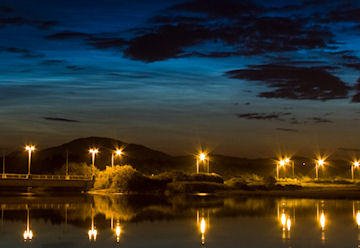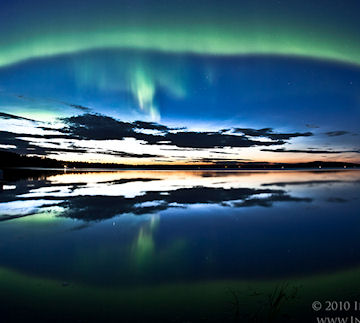NEW AND IMPROVED: Turn your iPhone or iPod Touch into a field-tested global satellite tracker. The Satellite Flybys app now works in all countries. | | | HUBBLE FINDS NO DEBRIS: Even the Hubble Space Telescope cannot find any debris where a meteoroid apparently hit Jupiter on June 3rd. Today, researchers released new HST images of the impact site, which show nothing but uninterrupted clouds. The non-detection is consistent with a relatively small asteroid making a shallow impact in Jupiter's high atmosphere. [more] CALFORNIA ROCKET: Last night, sleepless sky watchers in California witnessed a bright light streak across the sky. It was not a meteor. "A unarmed Minuteman III rocket was launched from Vandenberg AFB at 3:01 PDT," reports Anthony Galvan III who took this picture from his backyard in Goleta, CA. "The missile's target was near the Kwajalein Atoll in the Marshall Islands, 4190 miles from the launch site." [more] ELECTRIC BLUE CLOUDS: Observers in Europe are reporting brightening displays of noctilucent clouds (NLCs). "We had a lovely show last night," says Peter McCabe of Dundalk, Co.Louth, Ireland. "The electric-blue colors were striking." He took this picture using a Canon 450D: 
Photo details: Canon 450D, 20mm wide angle lens, 6 sec , f3.2, ISO100
"They were not the most intense NLCs I've seen, says McCabe, "but they bode well for the weeks ahead." Indeed, as northern summer unfolds, NLCs should become even more intense. The seasonal peak is not fully understood but it rarely fails to produce vivid displays in June and July. Another factor boosting these strange clouds near the edge of space is the solar cycle. There is a well-known correlation between noctilucent clouds and sunspots. NLC activity tends to peak during (and just after) years of solar minimum, possibly because low solar activity allows the upper atmosphere to cool, promoting the growth of ice crystals that make up the clouds. With the sun slowly emerging from a century-class minimum, the stage is set for a good season of NLC watching. more images: from Conor McDonald of Maghera, Ireland; from Martin McKenna of Maghera, Co. Derry, N. Ireland; from Pete Glastonbury of Avebury, Wiltshire, UK; from Stuart Atkinson of Kendal, Cumbria, UK; from George of Moscow, Russian Federation; Observing tips: Look west 30 to 60 minutes after sunset when the Sun has dipped 6o to 16o below the horizon. If you see luminous blue-white tendrils spreading across the sky, you may have spotted a noctilucent cloud. High-northern latitudes are favored. GEOMAGNETIC ACTIVITY: A solar wind stream is buffeting Earth's magnetic field and causing geomagnetic activity around the poles. Zoltan Kenwell sends this picture taken June 16th from a lake shore 150 miles north of Edmonton, Alberta: 
"The display was brief--only about 3 minutes from beginning to end--but beautiful," says Kenwell. "I was not disappointed!" NOAA forecasters estimate a 60% chance of more geomagnetic activity tonight as the solar wind continues to blow. High-latitude sky watchers should remain alert for auroras. May 2010 Aurora Gallery
[previous Mays: 2008, 2005, 2004, 2003, 2002] [aurora alerts] | 
